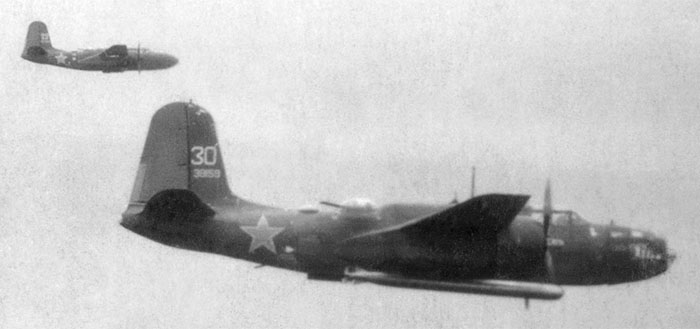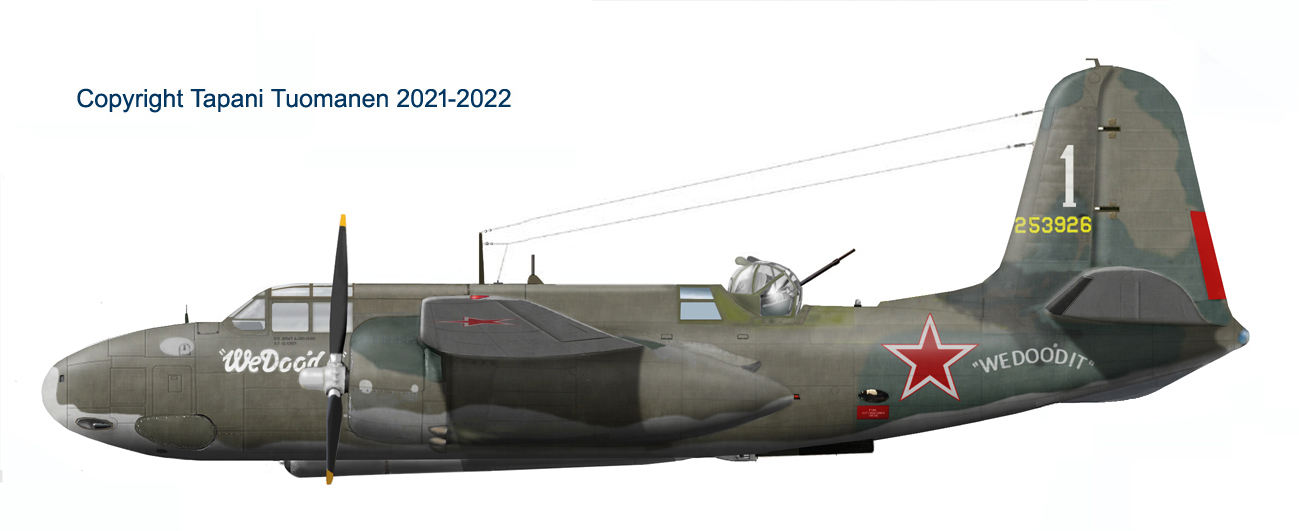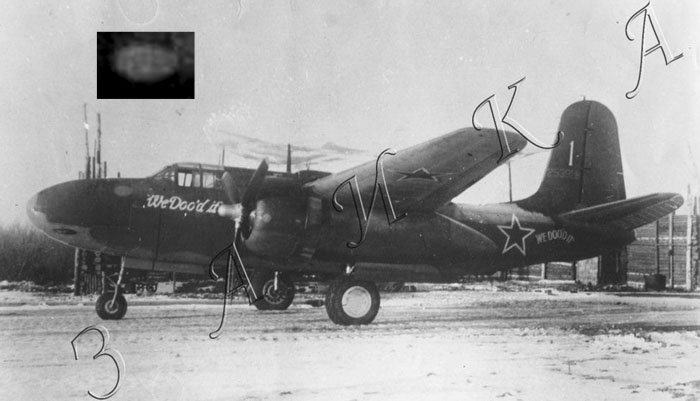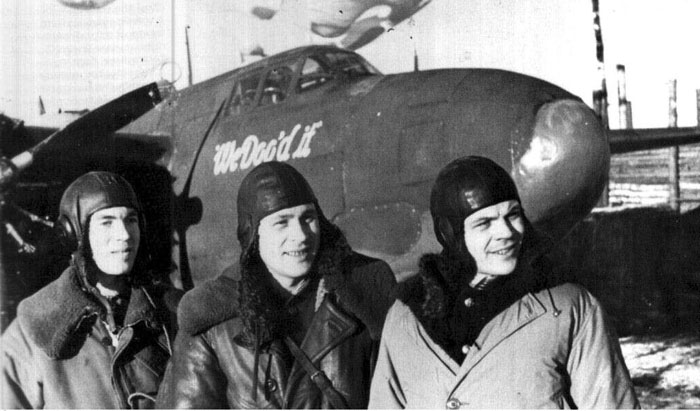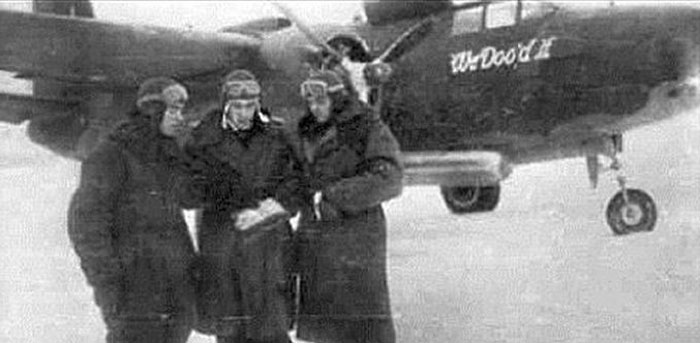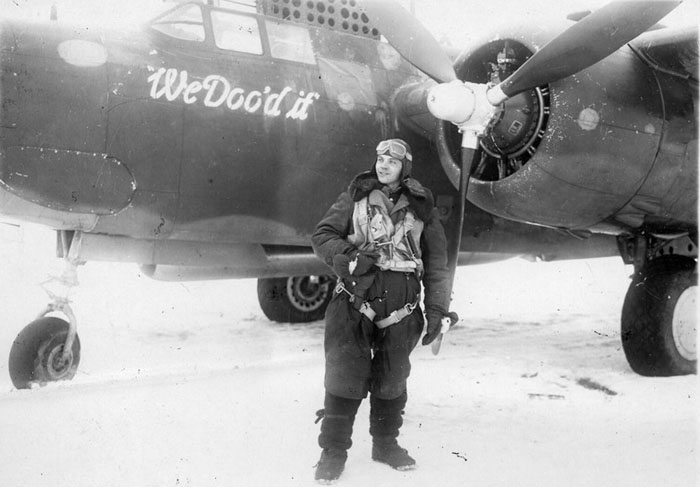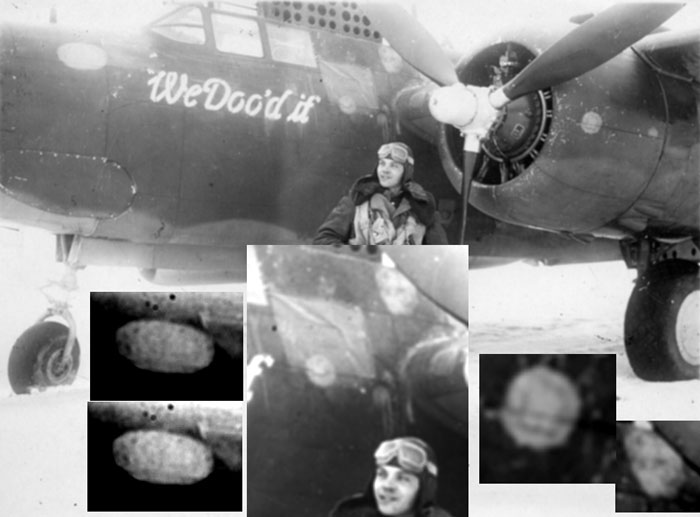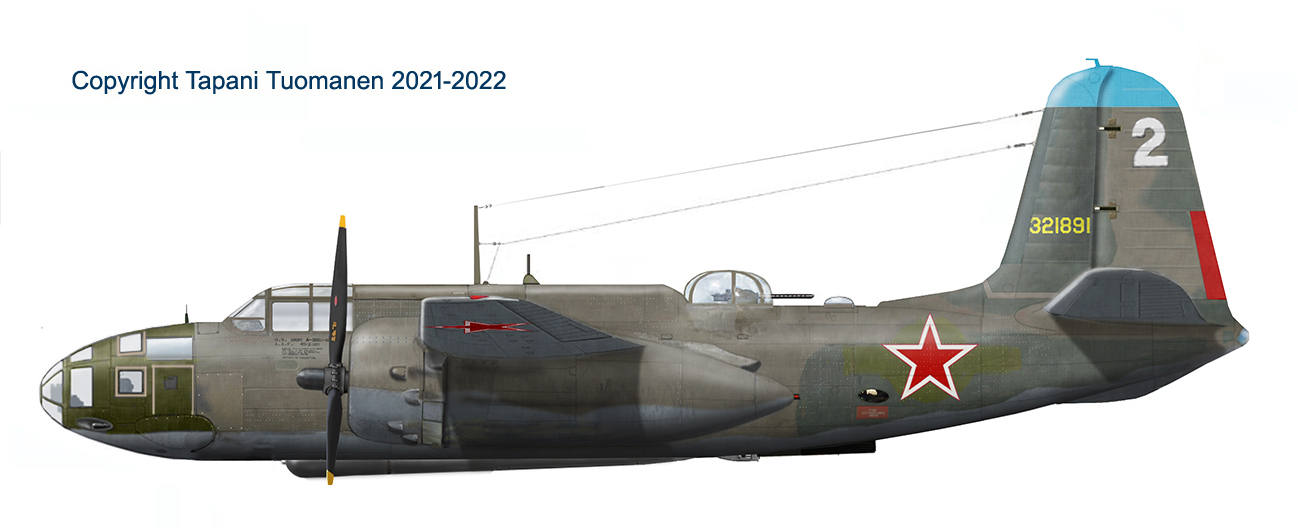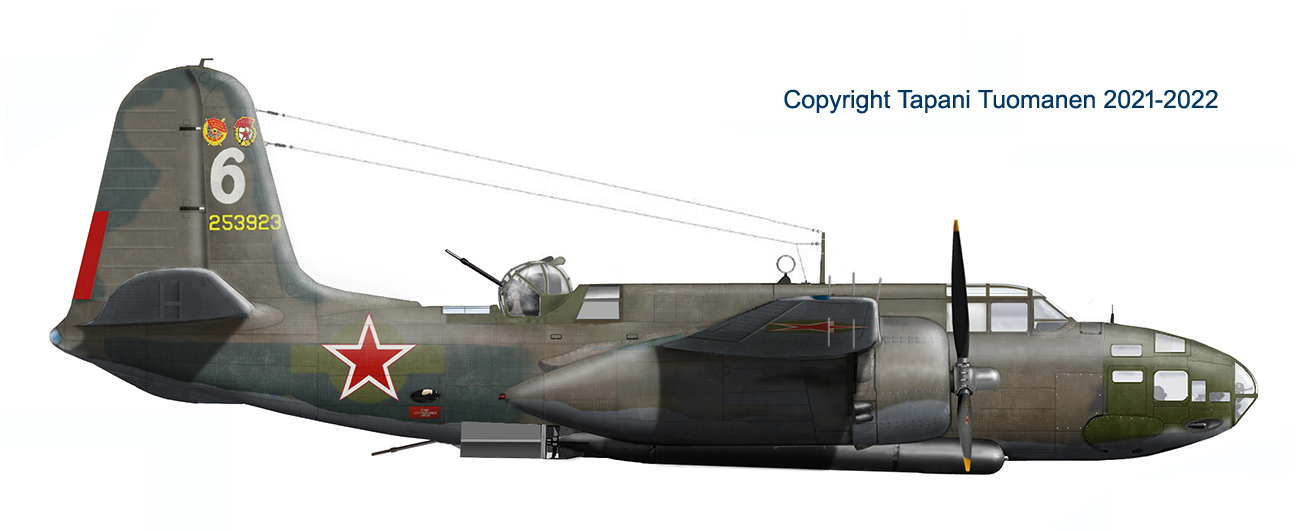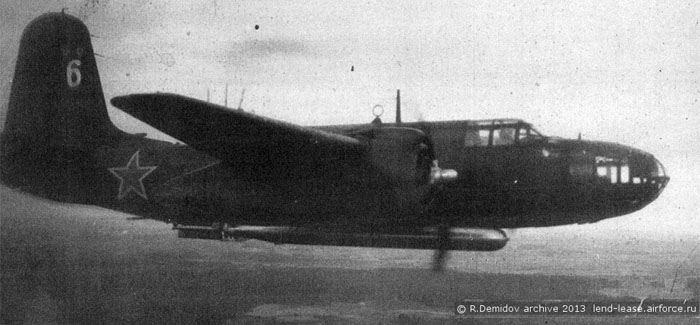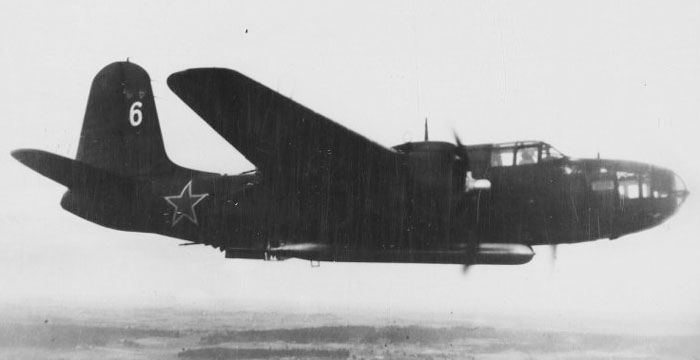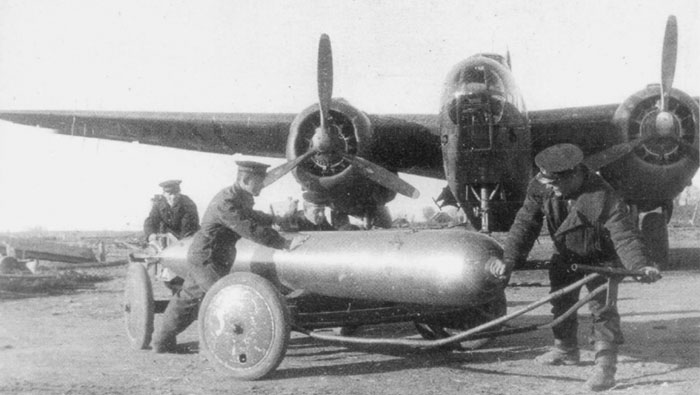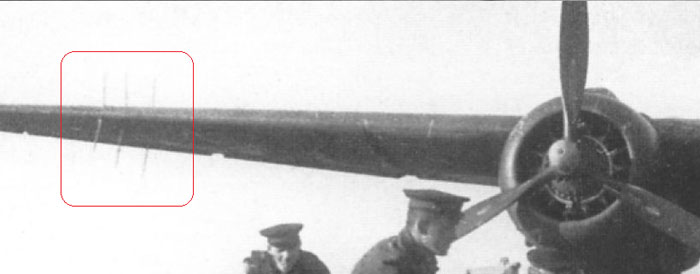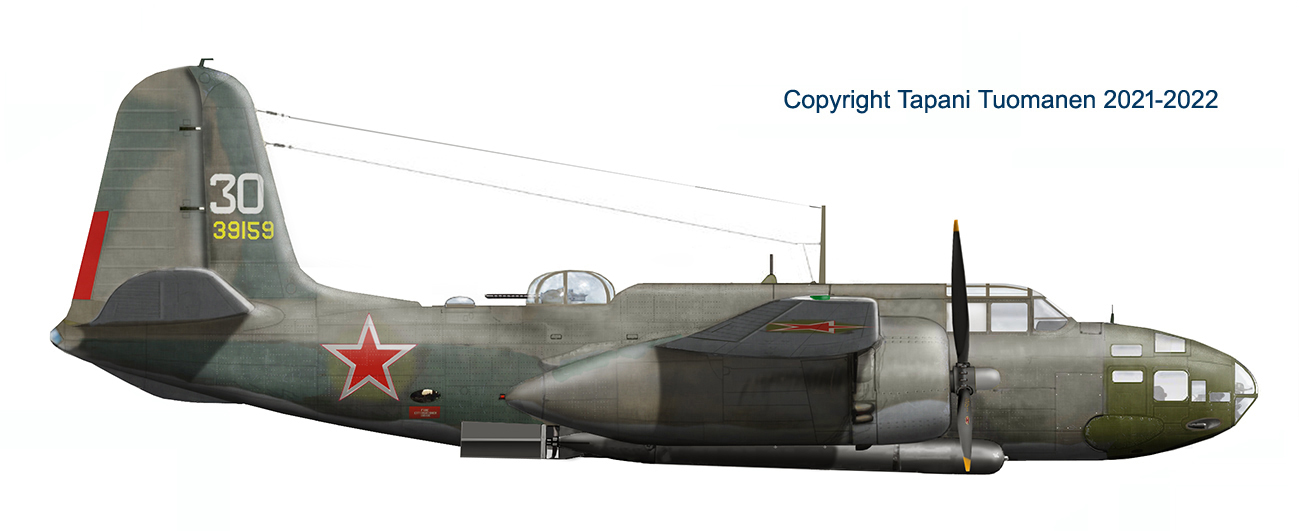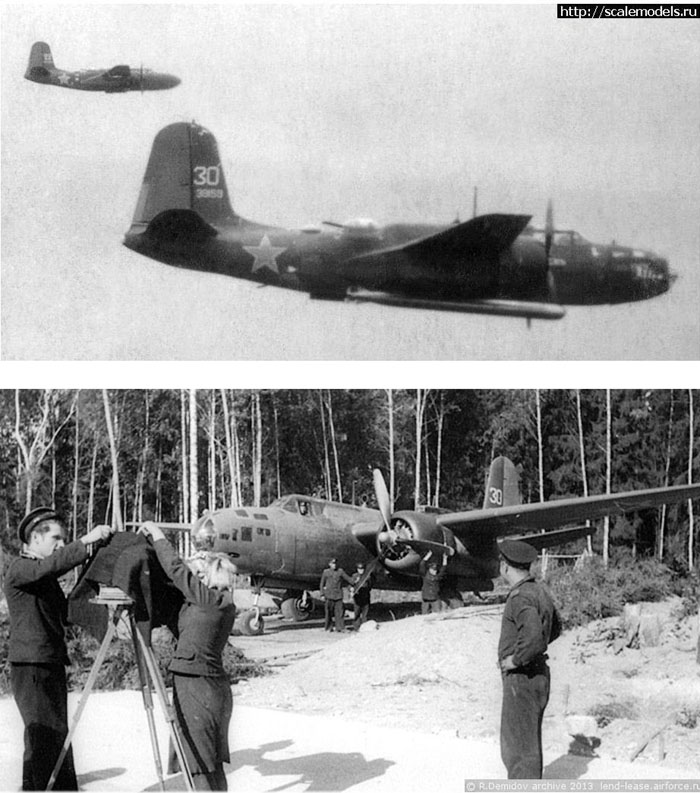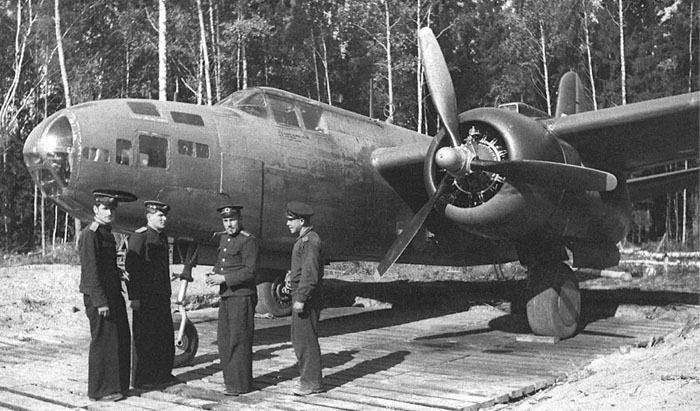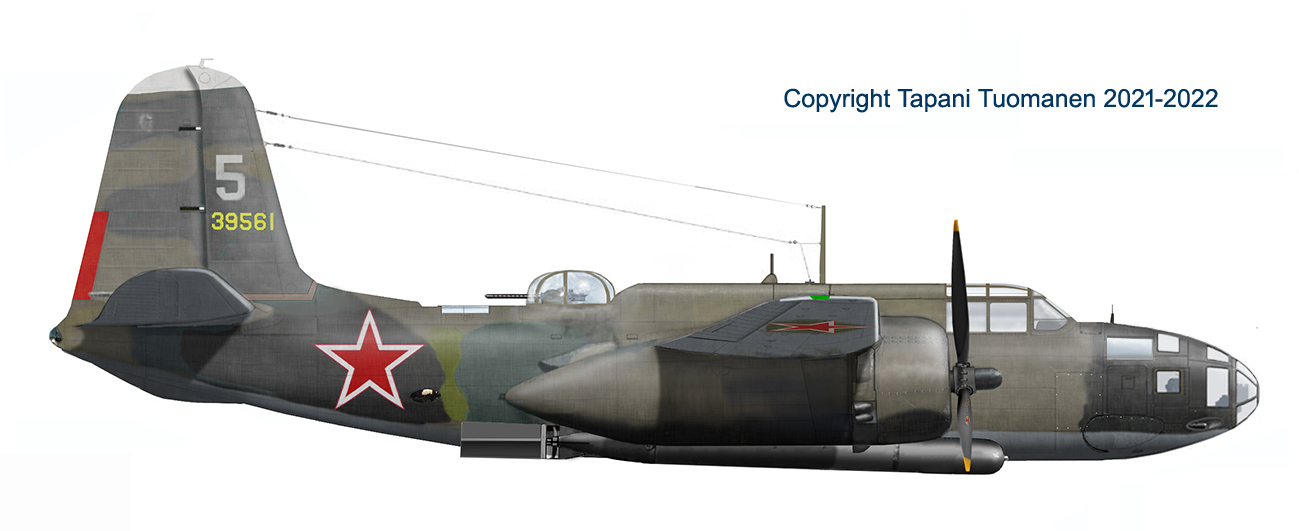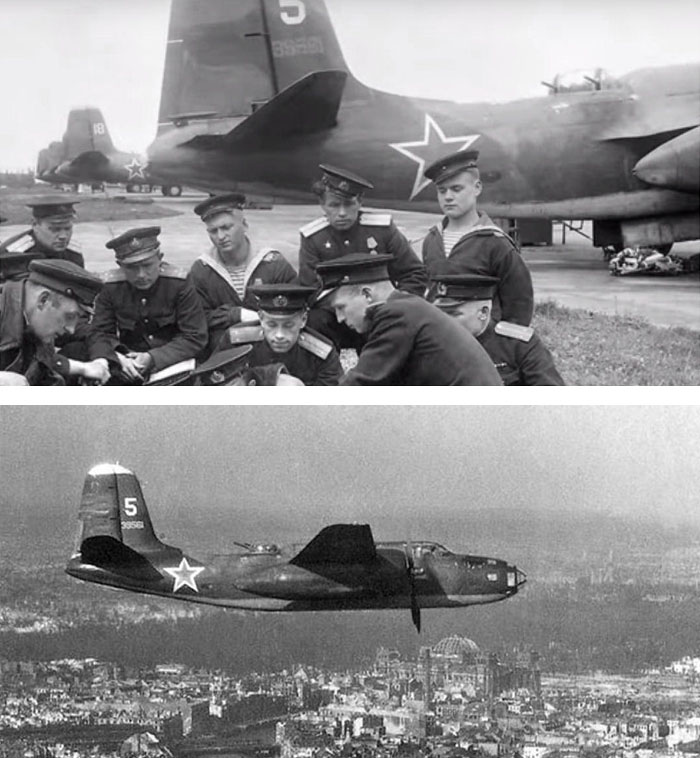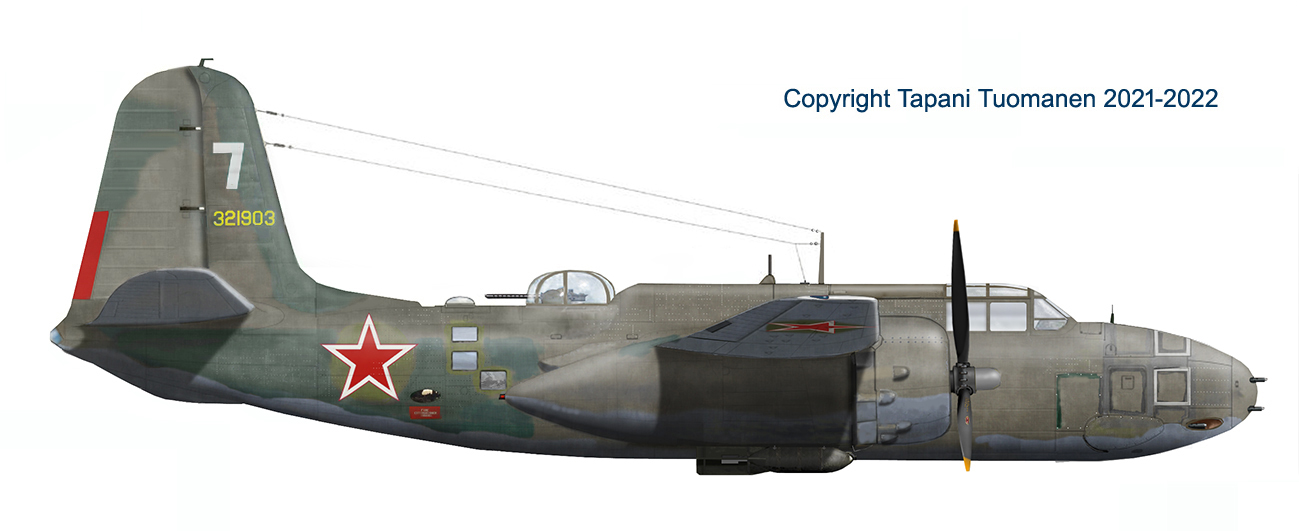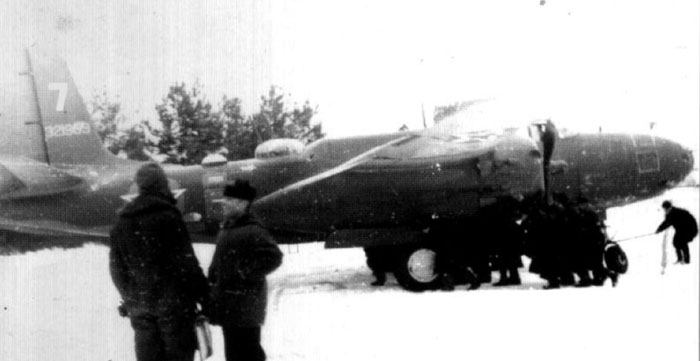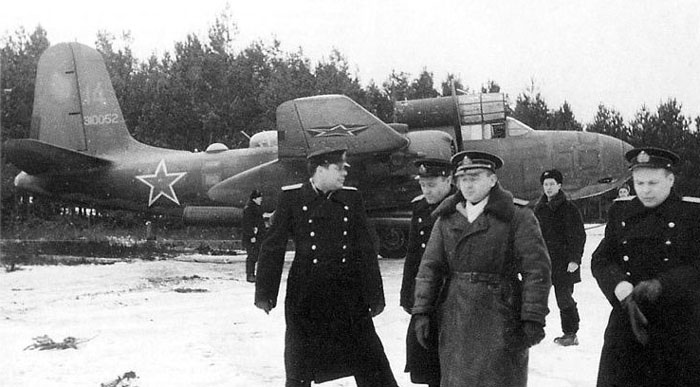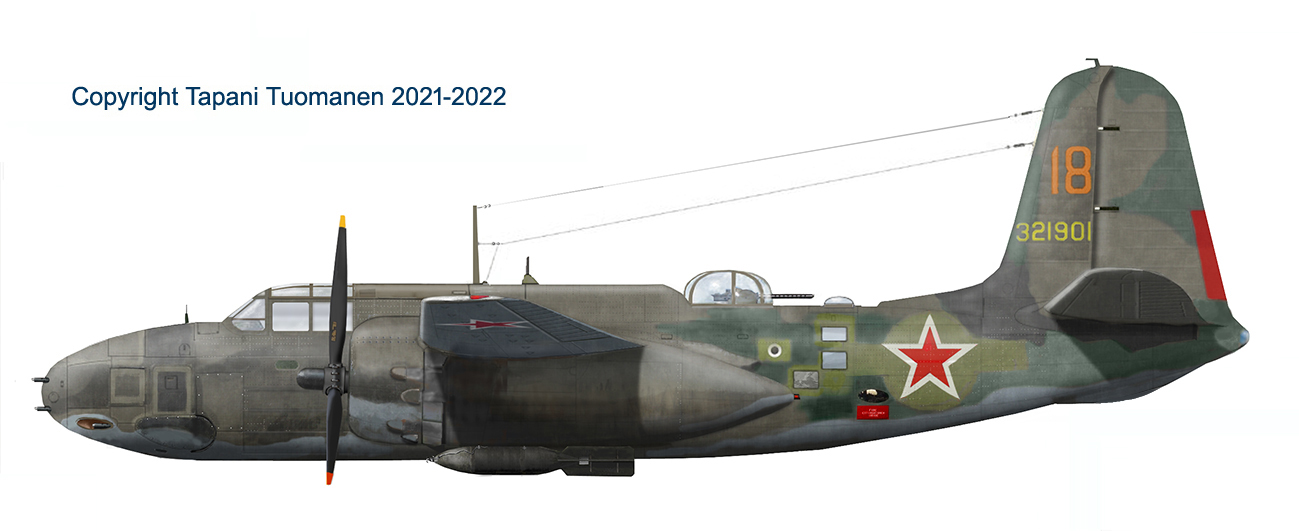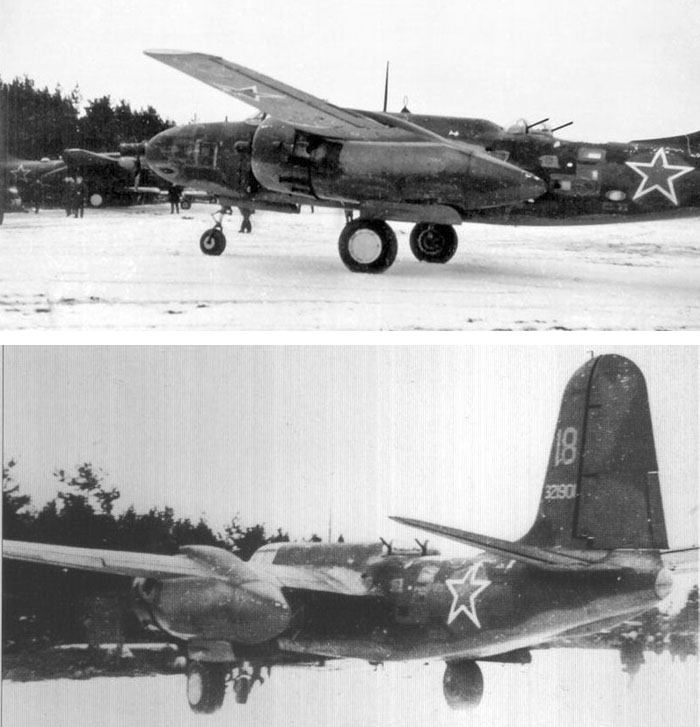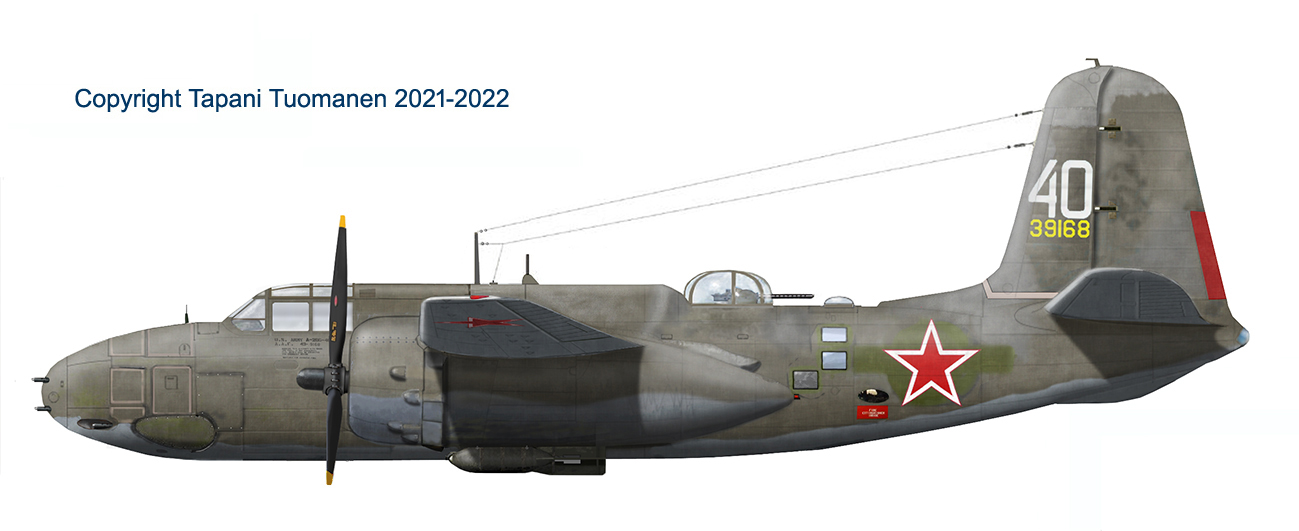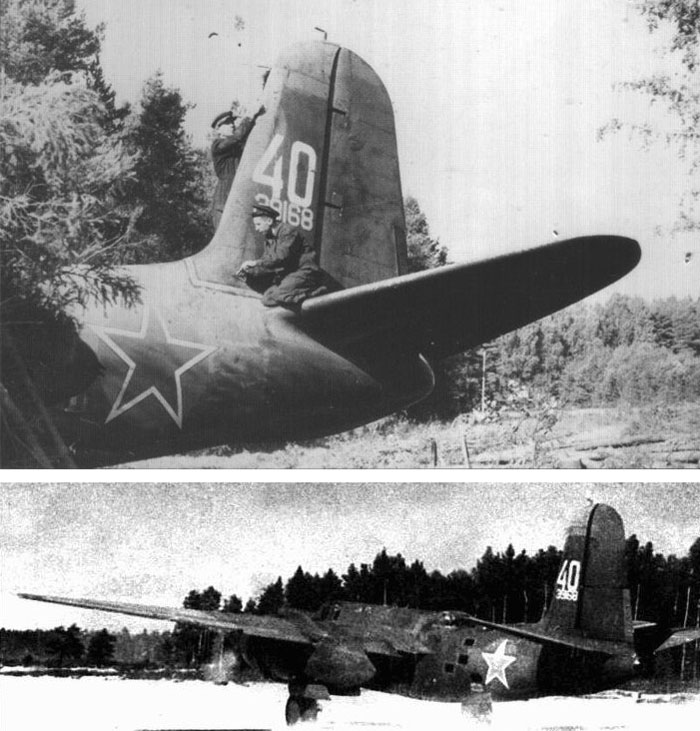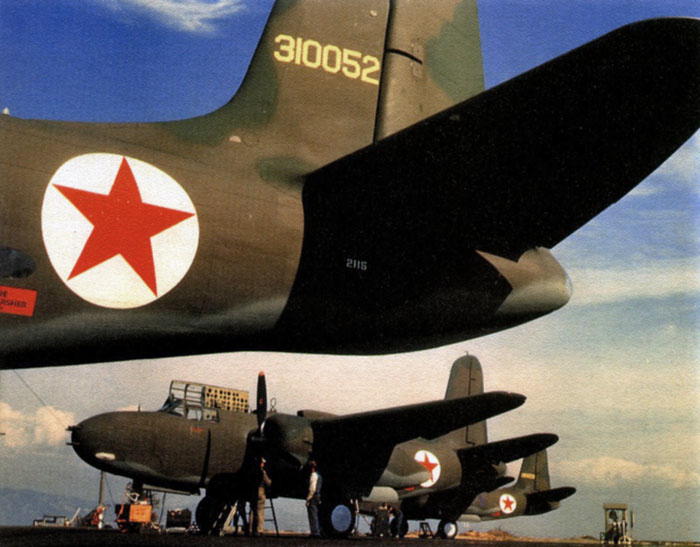
The first A-20G became operative in Soviet Union in the summer of 1943, where it was known as 'A-20 Zh', no more B-3 or Boston as previous versions.
The first series, G-1, were armed with an offensive armament of 4 x 20 mm guns and 2 x 12.7 mm machine guns in their nose, and had not a turret, but a 12.7 mm machine gun in dorsal position and a 7.62 mm one in ventral position.
Starting with A-20G-5 series (for some reasons, series were numbered 1, 5, 10, 15, 20 etc.), the 20 mm guns were replaced by 12.7 mm Browning machine guns, well distinguishable because much less protruding. The machine gun in ventral position still was a 7.62 mm Browning, unless Soviet replaced it with a more powerful weapon.
In Soviet service, the original dorsal machine gun position was often replaced by an UTK-1 turret armed with a UBT.
On the G-20 series, a power-driven Martin 250GE turret fitted with two 12.7 mm machine guns was fitted, with the fuselage15 cm wider in its upper part around the turret, and the ventral tunnel gun changed from a 7.7 mm to another 12.7 mm Browning. The engines were two 1,600 hp R-2600-23.
The A-20G was delivered from February 1943 and became quickly the most common version of this plane in Soviet service, with 1447 delivered to Soviet Union on 2850 totally built between late 1942 and 1944.
After A-20G, 30 A-20H were delivered in 1944. They were visually similar to late A-20G, but equipped with the 1,700 hp R-2600-29.
In U.S., this version with solid nose with strong fixed armament and crew of 2 was considered as a ground attack plane. The navy hadn't much interest for this, but the plane was adaptable for different roles.

In previous years, Bostons III and A-20B were delivered to the Navy at the same time of the Air Force, but they were scarcely useful as bombers due to their limited radius of action (1,380 km, less than a Pe-2) and the impossibility to carry large bombs able to destroy ships. In the Baltic fleet, these planes were used foremost as reconnaissance planes. B-3s were utilized as bombers in the Black Sea against harbors and airports, but they could bomb only in horizontal flight, not on dive, so they were scarcely able to hit moving ships.
The big success of A-20s in the Soviet Navy was when they were converted into torpedo bombers.
Being impossible to load the long Soviet torpedoes into the bomb bay, Soviet developed external structures called 'torpedo bridges' that were located on both sides of the fuselage. They consisted in two-T beams with wooden fairings at the ends, connected to a bridge spacer beam passing across the bomb bay; vertical rods connected the bridges with the lower surface of the wings, close to their roots. 2 T-18 torpedo holders were attached to the beams. The original underwing racks were removed.
The first tests were made in March 1943 on a DB-3C modified in Factory 81, specialized in modifications to foreign-built planes.
Later, starting from August 1943, Factory 89 converted some A-20Bs as torpedo bombers with the bridge; two UBK 12.7 mm machine guns with 250 rounds each were installed on the nose sides instead of the original 7.62 mm machine guns; the pilot had a K-8T gunsight, and the navigator had a NKPB-4 night bombing sight and a PTK-5 torpedo sight.
Below: drawings showing:
- the bridge pylons;
- FAB-500 and FAB-1000 bombs (two variants each)
- torpedoes 45-36AV-A, 45-36AN, 45-36AM.
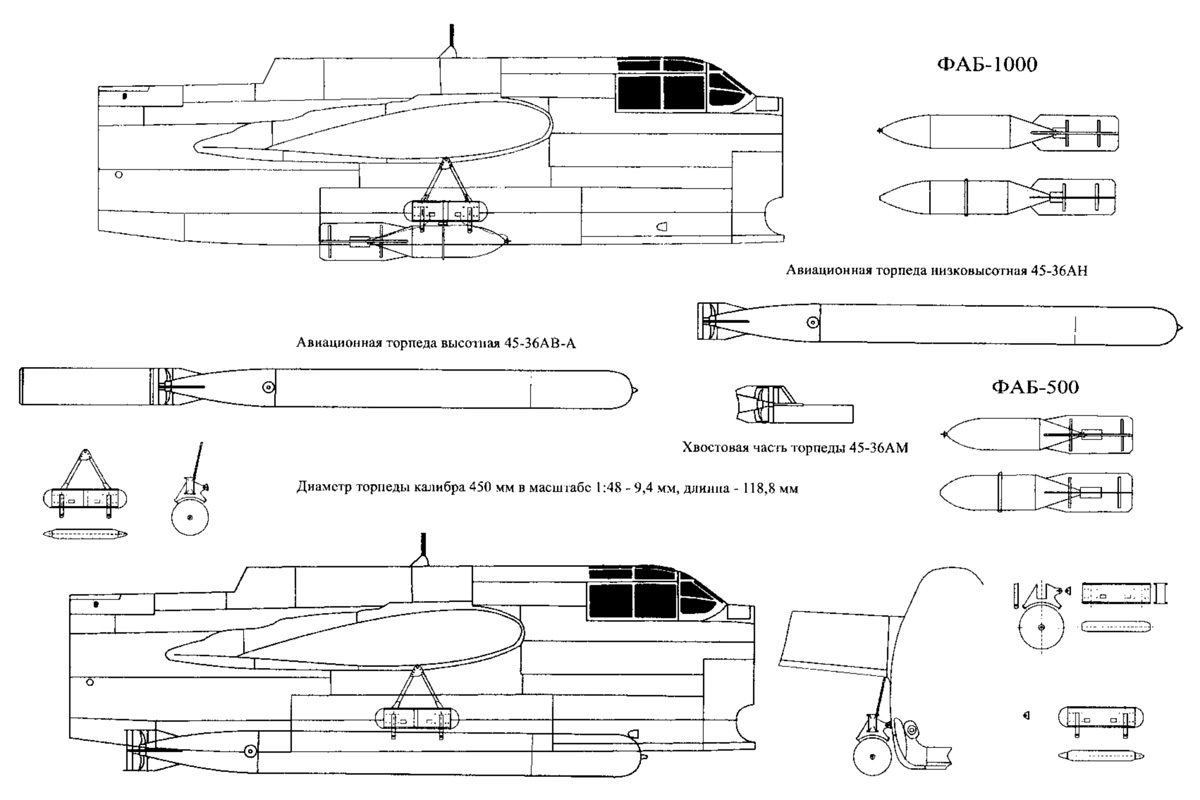
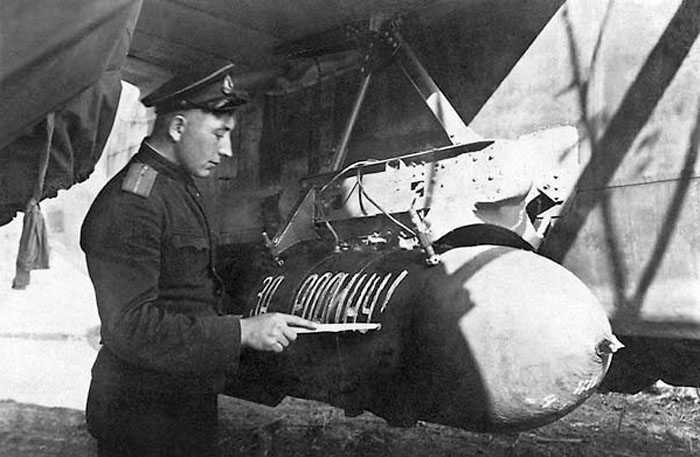
The defensive armament was remade, with the installation of the UTK-4 turret and the modified Pe-2 installation on the ventral hatch, both armed with UBT machine guns.
Additional tanks were installed in the bomb bay, usually not of the U.S. type that were unprotected, but of the type used on Pe-2s, suspended on belts; variants were possible due to the availability of parts. Tanks from Hampden were utilized too, and an inert gas system was installed, with the CO2 bottle under the navigator's seat, and the valve and pressure gauge were kept by the pilot. The oxygen system and the intercom were changed with Soviet ones. Bombs and torpedoes were dropped from various devices: bombs from ESBR-3, torpedoes from ESBR-6.
Bomb armament had two options: in one, original bomb racks could have been preserved in the rear part of the bomb bay, for a pair of FAB-100. In the second option, Soviet Der-21 cassettes were placed instead of the American bomb holders, and the bomb load rose to 400 kg.
The first converted A-20B was ready on August 9, then one each two days up to 36 planes.
Right: the bridges were useful to bring large bombs too: Fab-250, 500 and 1000. On the photo, 'Za Rodinu!' (For the motherland!) is readable on the bomb.

Bridges were used to carry mines:
- anchor mines AMG-1 of 500 kg (one on each side)
- bottom mines AMD-500 (one on each side)
- AMD-1000 used since September 1944, one mine usually on the right side)
- British bottom mines A Mk.1, A Mk IV, A Mk.V
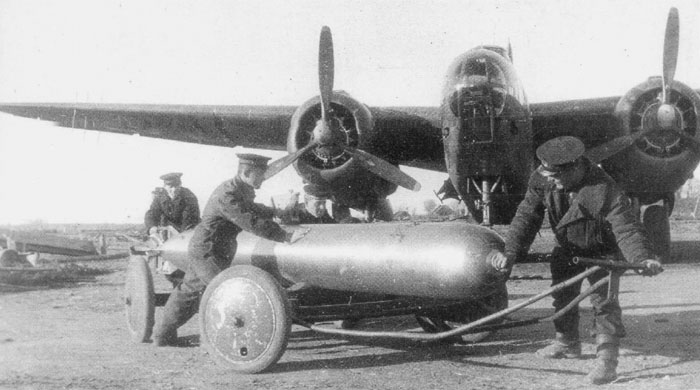
A-20G, having a solid nose, were more radically reworked, and in much greater number than previous versions.
The lack of a navigator was a severe handicap for the use as a bomber or torpedo bomber. So, apart for the bridge, the major conversion was the installation of a navigator's cabin. This could have been made in two ways:
- in the rear of the fuselage for planes not carrying torpedoes, but preserving the fixed armament on the nose to suppress the AA defenses of the targets before the torpedo attack; this conversion was designed in factory n.89;
- in the nose for torpedo bombers, that required a good visibility forward; this conversion was similar but not identical to those made in the Air Force for their bombers.
The full load of a A-20G with one torpedo was 11,303 kg, and this was the most usual case; rarely, A-20Zh could carry two torpedoes, with a full load weight of 11,623 kg , reducing the fuel load to not overload the landing gears.
Navy, modification 1: raiders
The easiest way chosen by the Soviet Navy to install a navigator's cockpit was putting it behind the gunner's position. The navigator acted also as ventral gunner, so the crew was of 3: pilot, dorsal gunner and navigator/ventral gunner.
A small clear cupola was installed just behind the turret, and three rectangular windows were added to each side in addition to the original oval one for the ventral mg position already present on all A-20s.
The solid nose was preserved, usually with its 6 x 12.7 mm Browning M2 machine guns armament.
These planes were not armed with torpedoes, but with medium/large caliber bombs suspended to the bridge. They flew in mixed formations with torpedo bombers and made the first attack on the ships trying to defeat their AA defenses. with machine guns, large bombs or a large number of 2.5 kg bomblets, just before the attack of torpedo planes.
Right: the cupola and three new rectangular windows for the navigator behind the turret are visible on the photo of this navy raider
Image from 'Bostony v Sovetskom Soyuze' of Vladimir Kotelnikov
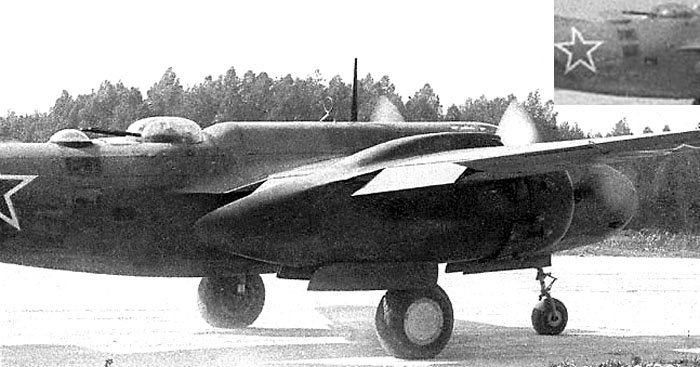
Right: A-20G White 5 of 1 GMTAP. The solid nose, the bombs bridge without bombs, the added windows on the rear fuselage, the extended flaps, the white wingtips and other details are noticeable. The red stars under the wings are in symmetrical positions, but only the one under the right wing lies on an overpainted U.S. emblem.
From https://bellabs.ru/51/index.html
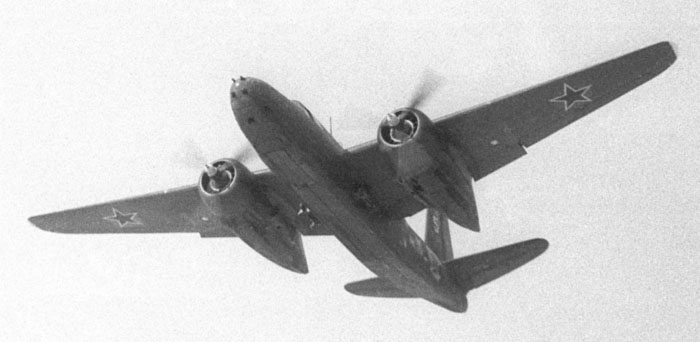
Navy, modification 2: torpedo bombers
Torpedo bombers needed a good forward visibility for the navigator/torpedo bomber; it was necessary to remove four machine guns to create space for him, and open windows. The lower pair of 12.7 mm machine guns was preserved.
This glazed nose was somewhat different from the modification made for the Air Force. 7 windows of different shape and size were put on each side, in symmetrical positions.
From https://bellabs.ru/51/index.html
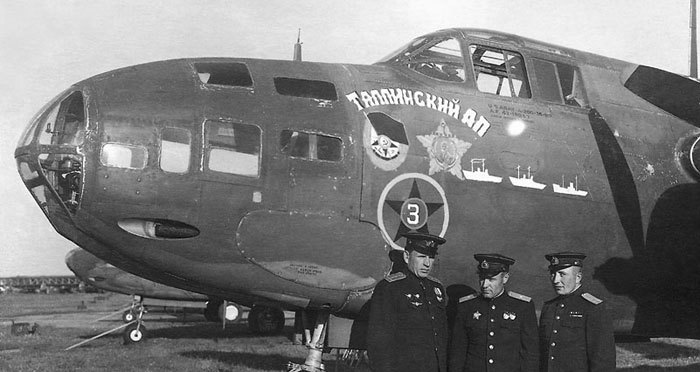
The front glazing had different framing from the one of the Air Force. The Navy's style one, seen from the front, showed frames resembling a sort of H.
There was a window on the lower surface, just after the frontal glazing; it was a bit narrower than the one of the Air Force variant.
The available images of the right side windows are poor, but it looks that they were symmetrical to those of the left side, apart the rear low window that was split into two sliding transparent panels on the left side, and uninterrupted on the right side.
This modification was seen foremost between the planes of the Northern and Baltic Fleet.
From https://bellabs.ru/51/index.html and other sources.
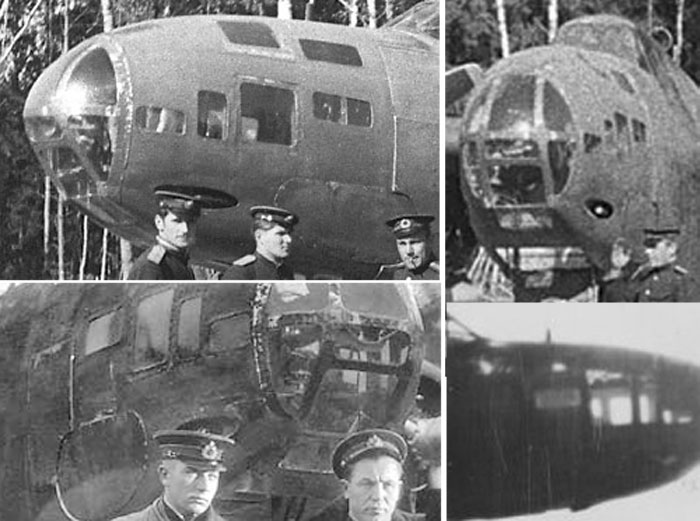
Navy, modification 3: torpedo bombers
An alternative style of glazed nose for the torpedo bombers of the Soviet Navy vaguely resembled the nose of Il-4s. It is not clear if this style was chronologically successive to the style 2, or it was made from another facility.
This type of nose had 5 windows on each side: two vertical just behind the front cupola, and 3 a bit rearwards.
Again, it was possible that a plane previously modified with the rear cockpit for the navigator to be used as bomber was later modified with the front cockpit to be used as torpedo plane; in this case the windows cut on the rear fuselage sides were overpainted, but the small cupola behind the turret was often preserved.
From https://bellabs.ru/51/index.html

The front cupola had 5 radial struts; the one downwards bifurcates to frame a small reverse U-shaped flat window. On the front, where struts join, we see a small round window.
There is a rectangular window for the bombsight on the lower part of the nose, just behind the cupola, although scarcely visible on these photos. The windows seem symmetrical on both sides.
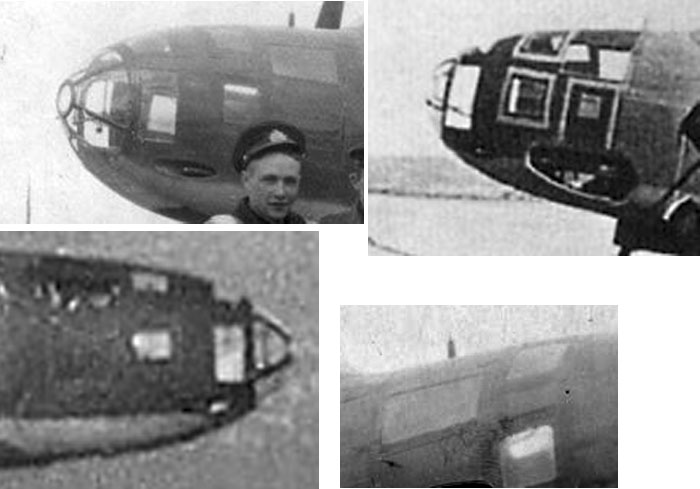
The first A-20G with torpedo bridges was received by the 1st GMTAP (Guards Mine and Torpedo Regiment) in the Baltic in March 1943, and flew aside Il-4s.
In October of the same year, the 51st MTAP Regiment was formed in the Baltic Fleet, armed only with A-20G.
The 9 Guards Mine and Torpedo Air Regiment received the new A-20G, replacing Il-4s and Hampdens.
In the Black Sea, the 36 Regiment received planes with torpedo bridge starting from July 1943; in April 1944 it was transferred to the Northern Fleet.
The Northern Fleet utilized strike groups with about the same number of torpedo bombers with glazed nose and attack planes with solid nose; The Black Sea Fleet utilized groups of 6-10 torpedo bombers with 3-4 attack planes, that supplemented the machine guns fire with a large number of small AO-2,5 fragmentation bombs to kill the AA gunners of the attacked ships before the torpedo attack.
Torpedoes were usually dropped at a distance of 600-800 m from the target, while flying at an altitude of 25-30 and a speed of 300 km/h.
Right: photo of two A-20G of 1 GMTAP. Plane 30 is armed with a torpedo and has the navigator lodged in the glazed nose; plane 22 on the background has solid nose with machine guns, heavy bomb load and the navigator's cockpit behind the turret. Strangely, plane 30 seems to have the navigator's cupola and painted-off windows on the rear of the fuselage, sign that the conversion was made twice, probably after the loss of another glazed-nose plane in the unit.
